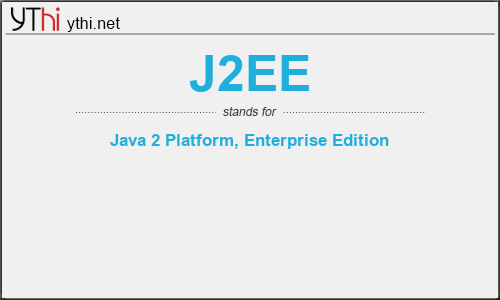What does J2EE mean? What is the full form of J2EE?
The full form of J2EE is Java 2 Platform, Enterprise Edition. It’s used on Computing ,Sofware & Applications in Worldwide
The Java Platform, Enterprise Edition (Java EE) is a collection of Java APIs owned by Oracle that software developers can use to write server-side applications. It was formerly known as Java 2 Platform, Enterprise Edition, or J2EE.
Jakarta EE, formerly Java Platform, Enterprise Edition (Java EE) and Java 2 Platform, Enterprise Edition (J2EE) is a set of specifications, extending Java SE 8 with specifications for enterprise features such as distributed computing and web services. Jakarta EE applications are run on reference runtimes, that can be microservices or application servers, which handle transactions, security, scalability, concurrency and management of the components it is deploying.
Jakarta EE is defined by its specification. The specification defines APIs (application programming interface) and their interactions. As with other Java Community Process specifications, providers must meet certain conformance requirements in order to declare their products as Jakarta EE compliant.
With the Java 2 Platform Enterprise Edition (J2EE), Sun has taken a first step in assembling a variety of Java component technologies to provide a standard integrated solution to developing web-based applications.
J2EE is a specification for a collection of software components to enable development of multi-tiered web-based applications. These software components include servlets, Java Server Pages (JSPs), and Enterprise Java Beans (EJBs) – technologies described in earlier articles.
J2EE is built on the Java2 Standard Edition (J2SE), utilizing its core functionality. The platform also includes a compatibility test suite to ensure J2EE-compliant applications will be portable across a variety of vendor implementations.
The platform is based on a standard 3-tier architecture with tiers named, respectively, the client tier (typically a web browser), the middle tier (the focus of J2EE), and the Enterprise Information System (EIS) tier (databases, ERP, or legacy applications). J2EE takes a variety of pre-existing standards and details the interaction of these components in an enterprise system.
The support for security, resource pooling, distributed transactions, and flexible component/application deployment on which EJBs are based is extended and further standardized in the J2EE platform. For example, the platform embraces XML as a standard format for data messaging and for descriptions of deployment properties.
The latest versions of specifications for many of the Java APIs (e.g., JDBC, JSP, and EJBs) feature changes that reveal Sun’s focus on higher-level issues of component compatibility and ease of development and deployment.
J2EE
means
Java 2 Platform, Enterprise Edition![]()
Translate Java 2 Platform, Enterprise Edition to other language.


Leave a Reply
You must be logged in to post a comment.